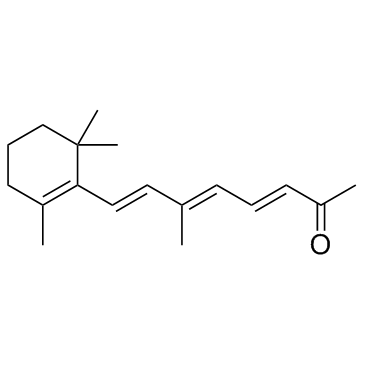17974-57-1
| Name | (3E,5E,7E)-6-methyl-8-(2,6,6-trimethyl-1-cyclohexenyl)-3,5,7-octatriene-2-one |
|---|---|
| Synonyms |
6-methyl-8-(2,6,6-trimethyl-1-cyclohexenyl)-3,5,7-octatrien-2-one
9-methyl-7-(1,1,5-trimethyl-5-cyclohexen-6-yl)-7,9,11-octatrien-13-one (3E,5E,7E)-6-methyl-8-(2,6,6-trimethylcyclohex-1-enyl)octa-3,5,7-trien-2-one β-apo-13-carotenone (2E,4E)-3-methyl-5-(2,6,6-trimethyl-1-cyclohexen-1-yl)-2,4-pentadienal (3E,5E,7E)-6-Methyl-8-(2,6,6-trimethyl-cyclohex-1-enyl)-octa-3,5,7-trien-2-one (3E, 5E, 7E)-6-methyl-8-(2,6,6-trimethylcyclohex-1-en-1-yl)octa-3,5,7-trien-2-one |
| Description | β-Apo-13-carotenone (D'Orenone) is a naturally occurring β-apocarotenoid functioned as an antagonist of RXRα. |
|---|---|
| Related Catalog | |
| In Vitro | β-apo-13-Carotenone is identified as enzymatic cleavage products of β-carotene in homogenates of intestinal mucosa of rat. β-apo-13-carotenone is found to antagonize the activation of RXRα by 9-cis-retinoic acid and is effective at concentrations as low as 1nM. Molecular modeling studies reveal that β-apo-13-carotenone makes molecular interactions like an antagonist of RXRα[1]. β-apo-13-carotenone competes for 9cRA binding to RXRα with an affinity (7–8 nM) identical to 9cRA itself. β-apo-13-carotenone antagonizes 9cRA activation of full-length hRXRα with a similar efficiency as the known antagonist UVI3003. β-apo-13-carotenone induces formation of the RXRα transcriptionally silent tetramer but does not inhibit coactivator recruitment to the isolated LBD[2]. The uptake and/or metabolism of β-apo-13-carotenone does not allow for accumulation of these β-carotene metabolites in cells. 3T3-L1 adipocyte marker gene expression is induced by β-apo-carotenoid treatment[3]. |
| Kinase Assay | Cos-1 cells are transfected in serum-free medium with three plasmids mixed in the following amounts per well, 0.05 µg of pRL-TK, 2 µg of pRXRE-luciferase, 2.5 µg of pSG5-RXRα in triplicates. Following transfection, the plates are incubated at 37°C in 5 % CO2 for 4 h. The medium is then changed to complete DMEM. Charcoal stripped FBS has been treated with activated carbon to adsorb lipophilic compounds including retinoids. Twenty hours after transfection, cells are treated with test compounds (β-Apo-13-carotenone) that are dissolved in ethanol or 0.1% ethanol alone for an additional 24 h. Cells are washed once with PBS and lysed by incubation with 500 µL passive lysis buffer for 15 min at room temperature. A 20-µL aliquot of cell lysate is then assayed for luciferase activities using a kit[1]. |
| References |
| Molecular Formula | C18H26O |
|---|---|
| Molecular Weight | 258.39800 |
| Exact Mass | 258.19800 |
| PSA | 17.07000 |
| LogP | 5.16070 |
| Storage condition | 2-8℃ |
